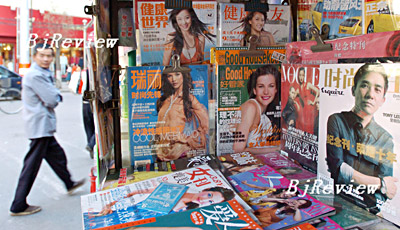
Electronic media versus print. Swords are drawn. There is no doubt that global print media companies have felt the impact of the Internet's rampant growth, where the duel for information, entertainment and news market share wages on.
Yet surprisingly in China, the world's most populous country, the periodical publication industry seems unaffected by the surge of cyberinfo. In fact statistics show that China's 20 years of high-speed growth has helped the periodical industry, and even the media industry at large, carve out new market niches and forecasts predict even bigger opportunities ahead.
The latest data from the General Administration of Press and Publications of China show that the total number of magazine titles in China amounted to a staggering 9,386 in 2006, printing a total of 2.85 billion copies worth 14 billion yuan. Ad revenue in 2005 also jumped to 2.9 billion yuan up from 500 million yuan a decade ago. Admittedly, the majority of these magazines are government-subsidized nonprofit publications but the scope of what the market can sustain is ocean deep.
Donald Kummerfeld, President of the Federation of International Periodical Press, affirmed that China will become a periodical publication giant as it has the largest reader group in the world, unified official language and a developed circulation and retailing channel.
This is borne out by a survey conducted by Yu Guoming, President of the Media Research Institute at Renmin University of China, which shows 131 million Chinese read magazines, or 19.25 percent of the total population.
White-collar workers with improved spending power make up the majority of buyers, and this group shows great potential of swelling as figures from the National Bureau of Statistics of China point out that the population of China's middle class will expand from 5.04 percent in 2005 to 45 percent by 2020.
An industry analyst points to the market potential underscored by the fact that less than 4 percent of the total domestic media ad revenues come from magazines. The proportion is considerably higher (13 percent) in foreign countries.
Where in the past advertising was of little interest to domestic magazine proprietors, times have changed and China has caught up with the rest of the world in terms of ad revenue-driven glossies with trendy informative content.
Although general media advertising has dropped to below 20 percent since 1998, magazine ads have seen explosive growth, making this section of traditional media, which include TV, radio and newspaper, the best performer by far, according to Yu.
On the newsstands it's all about status. Commercial magazine titles in China are attracting top luxury brand names and fashion labels. Aspiring global players in publishing cannot afford to be absent from this market, with big names like Conde Nast's Chinese version of the world's best selling fashion magazine, Vogue, launched in September 2005.
But sales are not up nationwide. Li Pin, a professor at the Beijing Institute of Graphic Communication, said the imbalance of economic development across the country means that while magazines are flying off newsstands in Beijing, Shanghai and Guangzhou, in smaller cities movement is slow. This will provide a rather huge area for the development of the industry.
With China's move towards globalization a stable of influential magazine brands have been let loose into the market since the early 1990s, with a large loyal readership, such as Cosmopolitan, Rayli, Reader (Du Zhe), Family (Jia Ting) and Bosom Friend. The rapid development of the industry has also swelled the ranks of reporters and editors in the race to produce better content than competitors.
Savvy publishers are now targeting their publications at niche markets. This has seen a flood of magazines for women, those working in the IT or financial industry, travelers and the like.
When broken down, four types of magazines are proving to be the most popular. They are B2B magazines or trade journals (such as CEOCIO China and Petrochemical Technology), news magazines (like South Wind Window and Sanlian Lifeweek), lifestyle and fashion magazines (the most successful are Cosmopolitan, Rayli and Elle), and China editions of leading foreign magazines (like Harvard Business Review and Sports Illustrated under Time Warner).
In addition to this trend, Li points to the phenomenon of multi-lingual magazines, generally service-oriented, and targeted at the growing expatriate community living in China.
Li also believes that B2B magazines will have a brighter future, as this type of magazine is highly profitable. He predicted that news and sociopolitical magazines are another area to watch with plenty of scope. "Social transition has left readers with lots of questions and the public need to find answers from the media," he said.
But although the industry is blessed with a rosy face, challenges loom ahead.
"As China has condensed what Western countries have done over a 100- to 200-year period, it will inevitably encounter various problems and difficulties that other countries have met," Zhang Zeqing, Vice Director of the Division of Periodical Publication Management under the General Administration of Press and Publications of China, told Beijing Review. Zhang pointed out the fact that the market is the ultimate test, as faced with so many choices readers are fickle and many magazines won't survive the fierce competition.
And this competition is mainly prevalent in the fashion and consumer type magazines, said Li.
Another aspect of the market war is the hunt for senior industry professionals. "As China hasn't a professional education institution specializing in periodical publications, experienced editors and marketing managers are in great demand," said Zhang.
As for the effect of the electronic media on the print publications, she admits that the Internet will no doubt have a deep impact on magazines. Already it is seen that a lot of magazines' content is lifted from the Internet, said Zhang. It is a sentiment echoed by Li, who worries that the reading habits of the next generation may change. "In the long term, the future of print media is quite unpredictable," he concluded. | 